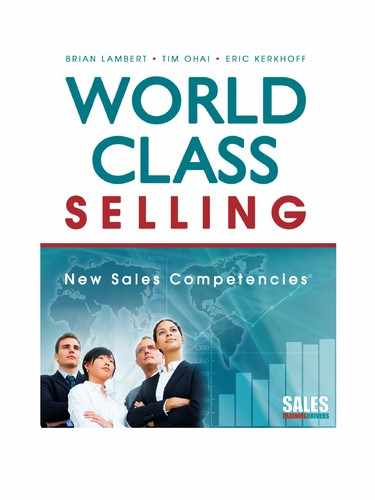Glossary
A guide to key terms used in World-Class Selling: New Sales Competencies.
Area of expertise: the specific technical and professional skills and knowledge required for success in sales specialty areas.
Buyer facilitation: a customer-focused selling approach that begins with identifying the buyer’s needs, proceeds through providing information and educating the buyer, then on to demonstrating the product’s value and results. Emphasizes influence over manipulation.
Buying organization: any company, association, team, person, or entity that has been identified as needing to purchase a product or service. A buying organization can be a prospect, or a current or previous customer or client to the selling organization. The buying organization and the selling organization can be part of the same company, association, or entity, but not usually the same team or person.
Category management: a retailing concept in which the total range of products sold by a retailer is broken down into discrete groups of similar or related products; these groups are known as product categories.
Customer: a buying organization that (may) buy repeatedly, but is not actively engaged on a regular basis by the selling organization.
Client: a customer that is regularly and actively engaged by the selling organization.
Competency: a cluster of related knowledge, skills, abilities, and behaviors that affects a major part of one’s job. A competency should correlate with performance on the job and have the ability to be measured.
Competency model: a structure designed to define the knowledge, skills, and abilities required for high performance that allows for a highly targeted training needs assessment and provides a roadmap to more objectively manage talent for competitive advantage.
Competency study: a rigorous, disciplined approach to defining exactly what members of a profession must know and be able to do to be successful.
Consultative selling: a sales approach that depends on a relationship between buyer and seller featuring trust, credibility, and mutual understanding; leverages the value proposition; and presents a compelling business case for the solution.
Leadership development: any activity that enhances the quality of leadership within an individual or organization and that focuses on developing the leadership abilities and attitudes of individuals.
Organizational performance: the outputs or results of an organization as measured against its goals and objectives.
Output: a tangible product that an individual delivers to others, especially colleagues, customers, or clients.
Result: a service that an employee renders to others.
Revenue generation system: a system for generating organizational profits through leveraging the subsystems of marketing, selling, infrastructure, and fulfillment.
Role: a broad area of responsibility. These are not job titles but different “hats” that people must wear to accomplish their jobs.
Sale: a unique transaction with deliverables and an exchange of money or its equivalent.
Sales process: a series of tactical and strategic steps that leads to the sales transaction.
Sales profession: the supportive business system and practices required to effectively develop, manage, enable, and execute a mutually beneficial, interpersonal exchange of goods or services for equitable value.
Sales stakeholders: anyone on the buying or selling side that is affected by the sale of a product or service.
Selling organization: any company, association, team, person, or entity that has defined and developed a product or service targeted to a specific market or markets.
Talent management: an organizational approach to leading people by building culture, engagement, capability, and capacity through integrated talent acquisition, development, and deployment processes that are aligned to business goals (ASTD, 2009).
Team selling: using the full resources of your company to sell an account through all of its relevant decision makers.
Workplace learning and performance: an organizational development approach defined by ASTD as the integrated use of learning and other solutions for the purpose of improving human performance and addressing individual and organizational needs. WLP uses a systematic process of analyzing and responding to individual, group, and organizational performance issues. WLP creates positive, progressive change within organizations by balancing human, ethical, technological, and operational considerations (Rothwell, Sanders, and Soper, 1999).
